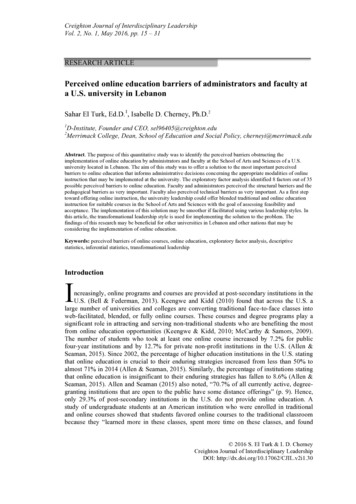
Transcription
EXTENSIONKnow how. Know now.GARTER SNAKES in andZ1782around theHOMEEDennis M. Ferraro, Extension Educator, andStephen M. Vantassel, Project Coordinator, Wildlife Damage
EXTENSIONKnow how. Know now.GARTER SNAKES in andEC1782around theHOMEEDennis M. Ferraro, Extension Educator, andStephen M. Vantassel, Project Coordinator, Wildlife Damage
Table of ContentsDescription. 4.Diet. 6.Reproduction and Growth. 7.Predators. 8.Parasites/Diseases. 8.Encounters. 9.Habitat Modification. 9.How Garter Snakes Get intoStructures. 10.Signs of Garter Snakes in andAround a Structure. 12.Snake Proofing a Home or Structure. 12.Removing a Garter Snake from aHome or Structure. 13.Repellents. 14 2011, The Board of Regentsof the University of Nebraskaon behalf of theUniversity of Nebraska–Lincoln Extension.All rights reserved.2Garter Snake Traps. 15.Toxicants and Baits. 16.
Figures 1-5.Garter snakes are usually 2-3 feet in lengthwhen full grown. However, Common gartersnakes have been recorded in lengths nearing4 feet. At birth most garter snakes are less than6 inches long. They grow little from birth in thelate summer until their first spring. From thatpoint, they grow fairly fast, reaching a youngadult length of almost 2 feet by the end of theirFigure 6. Shed skin of a commonfirst year.garter snake.Snakes shed their outer layers of skin asthey grow through a process called ecdysis(Figure 6). It is fairly common to find severalof these shed skins in your garden as growing snakes shed three to four times a year. Theshed skins are colorless, yet retain all the fea-
DescriptionHerpetologists reverethem, but many peoplefear them. We’re talkinggarter snakes — thoseslithering, shedding reptilesthat can make us shudder.Herpetologists, those whostudy amphibians andreptiles, appreciate theimportant role garter snakesplay in the natural world.Even if you’re not a fan ofsnakes, enjoy learning wheregarter snakes like to hang out,what they eat — and don’teat, and how best to deal withthem if you find some in yourhome or garden.4Four species or types of garter snakes residein Nebraska. The Common or Red-sided gartersnake (Thamnophis sirtalis) (Figure 1) and thePlain garter snake (Thamnophis radix)(Figure 2) are found statewide.The Ribbon garter snake(Thamnophis proximus)(Figure 3) is uncommon and is found inisolated areas in the far eastern portion of Nebraska. TheWestern Terrestrial or Wandering garter snake (Thamnophiselegans) (Figure 4) is rare and has been found only in theextreme northwest corner of the state. Garter snakes havecontrasting colored lines running lengthwise down theirentire body; three lines on the middle of the back and oneon each side. The position of the lateral or side lines differswith each species. The coloration of these line patterns andbackground pattern is extremely variable. While commonlycream, yellow, and orange stripes, some may be very darkor even bright red markings (Figure 5). Garter snakes withwhite and bluish coloration have been found in some urbanareas of Nebraska. A rule of thumb in Nebraska is any snakewith a line running down its body length mid-center and oneach side is one of our garter snakes.
Garter snakes are usually 2-3 feet in lengthwhen full grown. However, Common gartersnakes have been recorded in lengths nearing4 feet. At birth most garter snakes are less than6 inches long. They grow little from birth in thelate summer until their first spring. From thatpoint, they grow fairly fast, reaching a youngadult length of almost 2 feet by the end of theirFigure 6. Shed skin of a commonfirst year.garter snake.Snakes shed their outer layers of skin asthey grow through a process called ecdysis(Figure 6). It is fairly common to find severalof these shed skins in your garden as growing snakes shed three to four times a year. Theshed skins are colorless, yet retain all the fea-
tures of the snake’s pattern. A shed skin is usually 20 percent larger than the actual snake, as sloughed skin stretchesduring the process. These shed skins make an excellentlearning tool for youth who want to engage with the natural environment. Wash the shed with 70 percent isopropylalcohol (available over the counter at any pharmacy), drythoroughly, and keep in an airtight, clear plastic bag.Figure 7. Garter snakeeating an earth worm.Garter snakes have awide range of preyand are very opportunisticpredators.6Garter snakes are harmless and nonvenomous. Although possessing saliva and oral digestive glands, thesecretions from these glands aren’t harmful to the averagehuman or pet.DietGarter snakes have a wide range of prey and are veryopportunistic predators. They are obligatory carnivores,only feeding on other animal matter. They prefer softbodied prey such as earthworms, grubs, termites, andother soft insects. If near a garden pond or water source,minnows and frogs become preferred prey. Garter snakesdo not constrict their prey but rather rub them against theground or squeeze them against a fixed object with theirbodies until the prey can be swallowed. As with othersnakes, garter snakes must swallow their prey whole andare incapable of procuring a bite out of it. The size of thesnake’s mouth gap is its primary limiting factor. A gartersnake seldom will be able to feed on a mouse or rodent.These snakes also feed on carrion, especially dead worms.In the home garden, earthworms and grubs are by far theirNo. 1 food (Figure 7).
Reproduction andGrowthGarter snakes mate upon emerging frombrummation (hibernation). This usually occurs in early spring when the ground begins tothaw. Males usually emerge first and wanderaround trying to locate the scent of a female.There may still be some snow cover remainingwhen this occurs. When temperatures beginto rise above freezing during the day, femalesemerge and immediately release a pheromonescent that attracts every male snake of thatspecies in the area. These are the mating aggregations that you see in the spring. The largegrouping of snakes in lawns, gardens, and onrock walls comprise one female and maybe adozen males — an annual garter snake matingevent (Figure 8).Once mated, the female will wander off tohide and feed, and the males will leave andreturn to their original location. Female gartersnakes give birth to 12-20 young in late summer. There is only one mating and one litterper year. The young are less than 6 inches longand thin as a stirring stick. The females offerno care. The young must fend for themselvesand find food, primarily small worms, ant larvae, and termites. In the fall, clusters of youngsnakes can be found in gardens, where antnests with eggs are common.Figure 8. Garter snakes in an earlyspring “mating aggregation” or group.A garter snake reaches maturity and reproduces in two to three years. These snakes canlive for over 12 years. However, the chances ofa snake reaching 12 years of age are less than1 in 5,000. Over 90 percent of the young willdie before the next spring. Snakes require foodand heat from an outside source to grow.All temperate zone snakes are attracted towarm objects, which give them the heat theyneed for digestion, growth, and reproduction.They sun themselves during the day and hideat night. If snakes do not bask in the sun, they
Guide to allNebraska snakesand other reptilessnr.unl.edu/herpnebGuide to management ofwildlife encountershttp://www.extension.org/Garter snakes areconsidered terrestrialand subterranean animals.However, they can climb ifneeded.10and slabs. Rock walls known to harbor large numbers ofgarter snakes can be removed and replaced as solid cementstructures. Using rock or lumber walls that fit tight, withfew areas where snakes can find refuge, may decrease snakenumbers. Trimming plants, shrubs, and bushes, and eliminating branches close to the ground lessens the favorabilityof habitat. Also, removing debris and high vegetation mayincrease predation pressure on snakes.How Garter SnakesGet into StructuresSnakes are incapable of making a hole or entry into astructure either by gnawing holes or forcing their way inby pushing with their head through any solid material.They are able to squeeze through extremely small and tightopenings as small as 1/4 inch. Some of the most commonentry points include garage and basement doors, foundation cracks, basement window frames, dryer vents, outdoorwater faucets, sump pump drain lines, and around utilitylines.Garter snakes are considered terrestrial and subterranean animals. However, they can climb if needed. Snakeshave the ability to find friction points and wedge theirlong, slender bodies against the smallest projections toclimb vertically on structures. Smaller snakes have beennoted to climb up on brick- and stucco-sided homes. Garter snakes commonly wind their way to the top of shrubsand spread their weight across small branches to bask andwarm up (thermal regulate) in the sun. They also will use
Guide to allNebraska snakesand other reptilessnr.unl.edu/herpnebGuide to management ofwildlife encountershttp://www.extension.org/Garter snakes areconsidered terrestrialand subterranean animals.However, they can climb ifneeded.10and slabs. Rock walls known to harbor large numbers ofgarter snakes can be removed and replaced as solid cementstructures. Using rock or lumber walls that fit tight, withfew areas where snakes can find refuge, may decrease snakenumbers. Trimming plants, shrubs, and bushes, and eliminating branches close to the ground lessens the favorabilityof habitat. Also, removing debris and high vegetation mayincrease predation pressure on snakes.How Garter SnakesGet into StructuresSnakes are incapable of making a hole or entry into astructure either by gnawing holes or forcing their way inby pushing with their head through any solid material.They are able to squeeze through extremely small and tightopenings as small as 1/4 inch. Some of the most commonentry points include garage and basement doors, foundation cracks, basement window frames, dryer vents, outdoorwater faucets, sump pump drain lines, and around utilitylines.Garter snakes are considered terrestrial and subterranean animals. However, they can climb if needed. Snakeshave the ability to find friction points and wedge theirlong, slender bodies against the smallest projections toclimb vertically on structures. Smaller snakes have beennoted to climb up on brick- and stucco-sided homes. Garter snakes commonly wind their way to the top of shrubsand spread their weight across small branches to bask andwarm up (thermal regulate) in the sun. They also will use
may starve to death even though theyhave eaten prey. When approached they will try totake cover. If attacked orapproached, garter snakestry to defend themselvesby lunging with their mouth open(Figure 9). They will never offensively attack any person or pet astheir instinct is to flee predators ordanger. However, if they perceivethat they cannot flee, they willstrike repeatedly in defense.PredatorsIf attacked or approached,garter snakes try to defendthemselves by lunging withtheir mouth open.Crows, hawks, owls, badgers, raccoons, foxes, skunks,opossums, and other predators kill snakes. Human agricultural practices (row crops, vegetation removal, and marshdrainage) can make snakes more vulnerable to naturalpredators. Domesticated cats and dogs kill many gartersnakes each year.Parasites/DiseasesNo data indicates that snake parasites or diseases carried in wild populations transfer to humans or mammalianpets. Recent UNL research indicates that native, wild gartersnakes in Nebraska did not test positive for Salmonella bacteria or other health risks transmittable to humans.8
EncountersHabitat ModificationWhen a portion of the home range ofIt may be common to see many gartersnakes is disturbed in such a way that vegetasnakes around your home and garden. Plainstion is removed and cover habitat is destroyed,garter snake densities have been estimated atsnakes are no longer sighted in that area. Remore than 200 per hectare in some urbanizedducing the attractiveness of your propertyareas of Nebraska. Retaining walls, as well asto snakes by removing debris, rocks, brush,decorative gardens containing rocks or conwoodpiles, and tall grass that provide cover forcrete components, are a popular part of landsnakes may help reduce their numbers. Locascapes in residential locations. Garter snakestions that are more “sterile” looking, with lessfavor these objects, as well as debris piles, asrefuge. Human-snake encounters become very weedy vegetation and little cover, have very fewsnake populations. Garter snakes can only burcommon during spring and summer whenrow in loose soil. Cover loose soil with sharpsnakes move about searching for mates orgravel (lava rock) and caulking around stoopsfood, and people enjoy the outdoors.While garter snakes are abeneficial element in any ecosystem, many people fear them.Garter snakes may frightenyou, but they are actually harmless. Ophidiophobia, the fearof snakes, is noted in American literature and history. Thisfear is widespread; it may beinitiated by religious beliefs,folklore, an unpleasant experience, or psychological attitude.Whatever the reason, manypeople consider garter snakes anuisance around the home andgarden.Figure 9. Garter snake exhibiting defensivebehavior strike postion.
Guide to allNebraska snakesand other reptilessnr.unl.edu/herpnebGuide to management ofwildlife encountershttp://www.extension.org/Garter snakes areconsidered terrestrialand subterranean animals.However, they can climb ifneeded.10and slabs. Rock walls known to harbor large numbers ofgarter snakes can be removed and replaced as solid cementstructures. Using rock or lumber walls that fit tight, withfew areas where snakes can find refuge, may decrease snakenumbers. Trimming plants, shrubs, and bushes, and eliminating branches close to the ground lessens the favorabilityof habitat. Also, removing debris and high vegetation mayincrease predation pressure on snakes.How Garter SnakesGet into StructuresSnakes are incapable of making a hole or entry into astructure either by gnawing holes or forcing their way inby pushing with their head through any solid material.They are able to squeeze through extremely small and tightopenings as small as 1/4 inch. Some of the most commonentry points include garage and basement doors, foundation cracks, basement window frames, dryer vents, outdoorwater faucets, sump pump drain lines, and around utilitylines.Garter snakes are considered terrestrial and subterranean animals. However, they can climb if needed. Snakeshave the ability to find friction points and wedge theirlong, slender bodies against the smallest projections toclimb vertically on structures. Smaller snakes have beennoted to climb up on brick- and stucco-sided homes. Garter snakes commonly wind their way to the top of shrubsand spread their weight across small branches to bask andwarm up (thermal regulate) in the sun. They also will use
windowsills, window boxes, and other construction ledges on homes and other structures.Garter snakes of any size can climb upthe exterior of a building under siding. This isparticularly the case when homes have steelor aluminum siding installed over wood. Thesnakes may overwinter under the siding oradvance their way to the attic. Once in theattic, snakes usually burrow under the insulation and seek areas above light fixtures. On anumber of occasions, homeowners have foundsnakes hanging from their upper floor bedroom lights.
windowsills, window boxes, and other construction ledges on homes and other structures.Garter snakes of any size can climb up theexterior of a building under siding. This isparticularly the case when homes have steelor aluminum siding installed over wood. Thesnakes may overwinter under the siding oradvance their way to the attic. Once in theattic, snakes usually burrow under the insulation and seek areas above light fixtures. On anumber of occasions, homeowners have foundsnakes hanging from their upper floor bedroom lights.
Signs of Garter Snakes inand Around a StructureWhen garter snakes are living aroundhomes, the most visual signs are thesnakes themselves. Garter snakes don’tcreate and burrow their own holes. Theyutilize the holes of other animals or naturalcracks in the soil. Shed skins may be foundin the spring or late summer. Most adultgarter snakes shed two to three timesper year. These skins are generally eaten by rodents or insectsin a few days. Occasionally, fecalmaterial or droppings of a gartersnake are sighted on the surface of structures(Figure 10). This material is paste-like and appears as thick, dark-brown to black smears with awhite uric patch. On soil this fecal material breaksdown readily.Fortunately, snakes areeasily excluded fromstructures.12Snake Proofing a Home orStructureFortunately, snakes are easily excluded from structures.Seal and caulk all cracks and crevices in a manner consistent with proper weatherproofing. Fill gaps around allutility lines, pipes, and vents. Seals and barriers aroundwindows, doors, and garage doors should be tight andmade of a stiff, rubber-type material. Snakes can squeezeunder brush or loose foam sweep barriers. Dryer vents
need to have 1/4-inch screen covers. Thesecovers should be installed so they don’t impedeair flow or clog with lint. The base of all sidingneeds to be tight and firmly attached. All siding drain holes should be less than 1/8-inch indiameter. The exterior outlets of drain tiles andsump pumps need to have one-way valves or1/4-inch mesh wire. Plants, shrubs, and trellises adjacent to the structure will aid a snake’sability to climb and enter. A space of 2-3 feetbetween plants and the structure is recommended. A layer of copper wool or fine stainless steel fibers placed between downspoutsand the siding will deter snakes from climbingto attics.then turn the bucket upright, and carry thesnake out. Once a snake is released outdoors, itwill flee. Being trapped and captured is a negative experience for any snake, and it will attempt to avoid a repeat encounter.If the snake cannot be located in a home orstructure, look in dark areas that are warm andmoist. Primary hiding locations include: underhot water heaters, dryers, washing machines,and clothing piles on floors; and in heating vents and plumbing walls. Placing a padcovered with a slightly moist towel in a quietcorner of a room may entice the snake to hidein that location. A garter snake indoors is notRemoving aGarter Snakefrom a Home orStructureIf you know where thesnake is located, simply graspthe mid body with a glovedhand (leather, rubber, or vinylgloves work fine) and eithercarry the snake outdoors orplace it in a tall plastic bucket.You also may sweep the snakeinto a bucket horizontally,Photo courtesy of Pam GabrielFigure 10. Garter snake fecal matter dripping outfrom under the siding of a home.
While there arerepellents on themarket, most are ineffective indeterring snakes.looking for food but is trying to find a way to get outdoorsor find a warm hiding place.RepellentsMost repellents on the market are ineffective in deterring snakes. The result of one of the author’s investigationsclearly demonstrates that naphthalene, sulfur, or combinations of these chemicals failed to deter or repel the gartersnakes tested. Application of these substances in either asnake’s home range or unfamiliar habitat failed to alter itsnormal behavior. For a copy of this study, go to http://digitalcommons.unl.edu/gpwdcwp/432/. Garter snakes in thisstudy clearly ignored the potential repellents. The use ofchemical repellents is not recommended. A habitat of densevegetation provides garter snakes with cover against predation. These snakes utilize chemical traces to locate coverthey previously used.The presence of any foreign chemical odorant in thehome range during birthing or when snakes are seeking replacement cover can be a cue. In this case, normallyadverse odorants or repellents may act as an attractant.Homeowners applying a chemical repellent both in thesnake’s home range and nearby unfamiliar areas, such asnext to a patio, in hopes of curtailing snake encounters maybe creating the undesired effect. Chemicals placed in thehome range may be ignored, since odor cues and relatedresources are already present. Over time, the snakes habituate to the chemical repellents and associate the odor of therepellents with the home range. Hence, when migrating or14
searching for food, thesesnakes may be temporarily drawn to the unfamiliarlocation where the chemical was applied.It may be argued that ifa repellent gives any resultsor is perceived to help, itshould be available becausethe use of a “pseudo-repellent” may prevent peopleFigure 11. Garter snake crossing a repellent barrier.from illegally using poisonto kill snakes. However,it is irrational to place chemicals in the environment to act as a placebo and give an uninformed person temporary “peace of mind.”Recently, several additional substanceshave been marketed as snake repellents. Theyinclude mint oil, castor oil, cedar oil, and citrus acid oils. Preliminary data indicates theserepellents offer little deterrence (Figure 11).Extensive university tests are planned to determine the effectiveness of these materials.Garter Snake TrapsThe most common outdoor traps are funnel traps (Figure 12). They are long, screenedcylinders or wooden boxes with funnels atFigure 12. Funnel trap used forcapturing garter snakes.each end. The cylinders or boxes are usually6 inches in diameter or square and 2-3 feet inlength. Plastic or metal funnels are secured ineach end; the narrow ends (approximately1 inch) of the funnels are directed inward
toward each other while the wider (5-6inch) openings become the endsof the trap. Place the trapalong a structure or wallwhere snakes have beenseen. Leave overnight andcheck at least every 12hours.Sticky glue traps areanother trapping deviceused indoors. These arecommercially available or canbe made on site. Cut the ends out of anarrow, wide box. The box should be at least 1 squarefoot, yet less than 3 inches tall. Secure strips of doublesided carpet tape inside the bottom of the box. Place thebox in a warm, quiet location within the structure. Checkfrequently; if a garter snake is in the box, take the box outdoors and pour a couple ounces of vegetable oil along thesnake. The snake will then be able to work itself free.Remember that gartersnakes are beneficial,harmless to you and yourpets, and should not be killed.16Toxicants and BaitsThere are no toxic baits, sprays, poisons, or fumigantsregistered for snake control in Nebraska. Remember thatgarter snakes are beneficial, harmless to you and your pets,and should not be killed. Snakes fear people and pets, andif left alone, they will make every attempt to escape.
UNL IACUCInstitutional Animal Care and Use Commission#408Extension is a Division of the Institute of Agriculture and Natural Resources at the University of Nebraska–Lincoln cooperating with the Countiesand the United States Department of Agriculture.University of Nebraska–Lincoln Extension educational programs abide with the nondiscrimination policies of the University of Nebraska–Lincolnand the United States Department of Agriculture.
snakes have been recorded in lengths nearing 4 feet. At birth most garter snakes are less than 6 inches long. They grow little from birth in the late summer until their first spring. From that point, they grow fairly fast, reaching a young adult length of almost 2 feet by the end of th










